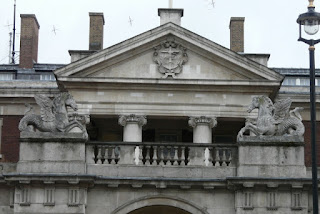 |
Blacksmiths in the Trade Procession
Preston Guild 1882 |
What is a Guild?
Guilds were established throughout England to regulate local trade and served for centuries as the economic heart of communities. Guild members received trading privileges, political power and social prestige, and controlled their trades by administering fines and punishments, including confiscating the goods of any ‘foreign’ traders.
Once every twenty Years
It became necessary to monitor who was entitled to the privileges of Guild membership, and thus began the ancient tradition of convening a Guild Court to renew those rights. The Preston Guild determined that a renewal once a generation, or every twenty years, would be sufficient.
We are not sure when the first Preston Guild was held. King Henry II gave Preston a charter in 1179, so there at least 800 years of history. The first surviving Guild Rolls are from 1397, so the 2012 Preston Guild will be only the 28th held in the last six centuries – which is why locals use the phrase ‘once every Preston Guild’ when a bus is late or a teenager says thank you.
A Rare Survival
By the middle of the eighteenth century free trade was rapidly creeping into the nation’s economy which made the Guild’s role increasingly irrelevant. By the end of the century Guilds were considered by many as redundant, which was confirmed by the 1835 Municipal Corporations Act which officially abolished all Guild powers.
In most towns and cities the Guilds just evolved into a new form of local government, and their Courts, rolls, and celebrations disappeared into the mists of antiquity. Yet Preston’s Guild continued, even though the reasons for its existence had disappeared, and it had neither legs or teeth to regulate or influence. The amazing fact is that Preston is the only surviving Guild Court in the whole nation.
Why?
What did Preston see in the Guild that was worth preserving and celebrating?
First is a sense of tradition. There is something quite magical to think that the hundreds of people who renew their ‘rights’ in 2012 are doing so in the same fashion as their forefathers did in 1397. It is a delightful link to the past.
Secondly it is fantastic for trade. Originally Guild members promenaded to display their position and rights. Now the Guild provides businesses with an unrivaled opportunity for publicity. The past two Guilds have seen around a million people descend on Preston during the week long celebrations, and that does wonders for the local economy.
Thirdly it is a perfect excuse for some fun. Entertainment has always been big on the agenda for a Preston Guild. Since the 1842 Guild a major difference was the change of focus as a celebration for the whole community rather than elitist activities for a privileged few.
Over the years there has been a dizzying array of activity including: horse racing, cock fights, football, pipers, fiddlers, trumpeters, processions, promenades, hot air balloon ascents, balls, banquets, concerts, recitals, plays, assemblies, circuses, wild beasts, fairgrounds, and fireworks. No wonder that an 1822 visitor declared that Preston “presents an appearance of so much gaiety and bustle as to defy description.”
In 2012 the whole city once again erupted into a phenomenal array of colour and sound and activity. Don’t miss your next chance to be part of history and witness this unique and exciting spectacle.... in 2032! Put it in your calendar.
See our Preston Guild Walking Tour
Join us as we explore Preston's town centre and discover tales from Guilds past. Visit
www.obelisktours.co.uk.






































